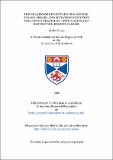Files in this item
The relationship between DNA double-strand breaks and mutation induction following treatment with X-rays and restriction endonucleases
Item metadata
| dc.contributor.advisor | Bryant, Peter Edward | |
| dc.contributor.author | Singh, Baldev | |
| dc.coverage.spatial | 194 p., 6 p. of plates. | en_US |
| dc.date.accessioned | 2018-06-19T11:22:36Z | |
| dc.date.available | 2018-06-19T11:22:36Z | |
| dc.date.issued | 1992 | |
| dc.identifier.uri | https://hdl.handle.net/10023/14249 | |
| dc.description.abstract | DNA double-strand breaks (dsb) are thought to be major radiation-induced lesions in biological end-points such as cell lethality and chromosome aberrations. Based on this notion, this project aimed to extend further the investigation of the role of dsb in radiation-induced mutagenesis. The initial part of the project involved optimising conditions for the mutation assay so as to select for 'true' tk-mutants in Chinese hamster cells, following treatment with X-rays. This was important, due to the insufficient previous mutation data involving this locus in Chinese hamster cells. Furthermore, the choice of the tk locus over the more commonly used hprt locus was based on existing evidence of its higher sensitivity, as found in mutation experiments with the L5178Y mouse lymphoma cell line (Evans et al, 1986). An Initial comparative study was carried out to measure the induced mutation frequency following X-ray irradiation in both the parent Chinese hamster Ovary (CHO KI) cell line and its X-ray- sensitive mutant (xrs 5) cell line. This mutant line was chosen because of its characteristic marked deficiency in dsb repair, yet normal ability to rejoin single-strand breaks (Kemp et al, 1984., Costa and Bryant, 1988). This allowed the study of the role of dsb in mutation induction. The enhanced mutation induction observed in xrs 5 over that in CHO KI cells suggested the Importance of dsb in radiation-induction mutagenesis. The next experimental strategy adopted involved the use of the DNA synthesis inhibitor, 9-D-arabinofuranosyladenine (ara A). The choice of this drug was based on previous work by Bryant and Blocher (1982) and Iliakis and Bryant (1983) who, using DNA unwinding and neutral velocity sedimentation, showed ara A to strongly inhibit dsb repair, Plateau-phase CHO KI cells were exposed to X-rays alone or in combination width ara A , the latter treatment showing an increased induction of mutations. This suggested the possible existence of dsb which are fixed as mutations in the absence of DNA polymerization, suggesting a sub-class of dsb which may be critical in the steps leading to the induction of a mutation. XV The third approach was to use restriction endonucleases (RE) which were introduced into cells by electroporation. This method unlike ionising radiation, induced 'pure' dsb. The use of this method was based on the work of Bryant (1984), who used RE to mimic radiation-induced damage in the induction of chromosomal aberrations. Two different types of RE were used: those which produce blunt- and those which produce cohesive-ended dsb. In all mutation experiments with these enzymes, blunt-ended dsb were found to be more effective in generating mutations compared to cohesive-ended dsb. This suggests a possible further resolution of type(s) of dsb that would be induced by radiation in the ability to induce mutations i.e dependent on the end-structure of the induced dsb. Blunt-ended dsb may thus represent the major type of critical pre-mutational lesions which may be fixed as a mutation, as a result of misrepair. Cohesive- ended dsb may be of lesser importance. Finally, a RE (Pvu II) which generates blunt-ended dsb was used to induce mutations at the hprt locus in Chinese hamster (V79) cells. DNA from mutant cells was analysed using Southern blot and PCR analysis of 3 exons in the hprt gene. Some of the mutants (5/15) showed large deletions (representing complete loss of the gene), a change similar to that observed in mutants Induced following treatment with ionising radiation (e.g. Thacker, 1986). However, the percentage of large deletion mutants (70%) observed in radiation- induced mutants was higher than that (~34%) obtained with RE- induced mutation data. This preliminary data on the analysis of RE- induced mutations suggests that blunt-ended dsb mimics radiation- induced pre-mutational lesions, resulting in some large genomic changes (e.g. large deletions). However, a larger number of RE- induced mutants would have to be analysed before a more accurate comparison between RE and ionising mutation data can be made. In summary, this study provides evidence for dsb as a major pre-mutational lesion in cells exposed to ionising radiation, and suggests the existence of a sub-class of dsb in relation to mutation induction. In addition, RE offer the possibility of gaining further understanding of the role of dsb in the origin of mutations such as those caused by deletions. | en_US |
| dc.language.iso | en | en_US |
| dc.publisher | University of St Andrews | |
| dc.subject.lcc | QP623.S5 | |
| dc.subject.lcsh | RNA | en |
| dc.title | The relationship between DNA double-strand breaks and mutation induction following treatment with X-rays and restriction endonucleases | en_US |
| dc.type | Thesis | en_US |
| dc.contributor.sponsor | British Nuclear Fuels (Firm) | en_US |
| dc.type.qualificationlevel | Doctoral | en_US |
| dc.type.qualificationname | PhD Doctor of Philosophy | en_US |
| dc.publisher.institution | The University of St Andrews | en_US |
This item appears in the following Collection(s)
Items in the St Andrews Research Repository are protected by copyright, with all rights reserved, unless otherwise indicated.

